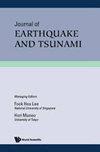Derivation, Validation, and Numerical Implementation of a Two-Dimensional Boulder Transport Formulation by Coastal Waves
IF 2.1
4区 工程技术
Q2 GEOCHEMISTRY & GEOPHYSICS
引用次数: 4
Abstract
Numerical computations for boulder transport have become a state-of-the-art tool for hindcasting the hydraulic processes associated with past storm wave and tsunami events. Since most previously developed two-dimensional formulations cater to boulders with symmetric outlines, they can consequently reproduce the transport distance and the velocity of boulders of cubic shape or similar structured geometries reasonably well. However, the formulations exhibit limitations when applied to rectangular- and flat-shaped boulders. The presently available formulations have difficulties reproducing the variations of frictional drag force due to the changes of the boulders’ contact time with the ground. We have developed an extended boulder transport formulation and derived a new empirical roughness coefficient by considering the shape of boulders that accounts for the changes of the boulders’ contact time with the ground. In comparison to other existing transport formulations, the present method provides superior accuracy of block velocity and transport distance in most cases — especially for boulders of rectangular geometry. Even by neglecting the full three-dimensional processes, numerical computations extended with the proposed boulder transport formulation can help explaining historic wave regimes, which were responsible for the transport of a variety of coastal boulders reported around the world.推导,验证,和数值实现二维巨石传输公式的海岸波
数值计算的巨石运输已成为一个先进的工具,以预测水力过程与过去的风暴和海啸事件。由于大多数先前开发的二维公式迎合具有对称轮廓的巨石,因此它们可以相当好地再现立方体形状或类似结构几何形状的巨石的传输距离和速度。然而,当应用于矩形和扁平的巨石时,这些配方表现出局限性。目前可用的公式难以再现由于岩石与地面接触时间的变化而引起的摩擦阻力变化。我们开发了一个扩展的岩石输运公式,并通过考虑岩石的形状推导出了一个新的经验粗糙度系数,该系数考虑了岩石与地面接触时间的变化。与其他现有的输运公式相比,本方法在大多数情况下,特别是对于矩形几何形状的巨石,提供了更高的块体速度和输运距离的精度。即使忽略了完整的三维过程,用所提出的巨石搬运公式扩展的数值计算也可以帮助解释历史波浪状态,这是世界各地报道的各种海岸巨石搬运的原因。
本文章由计算机程序翻译,如有差异,请以英文原文为准。
求助全文
约1分钟内获得全文
求助全文
来源期刊

Journal of Earthquake and Tsunami
地学-地球化学与地球物理
CiteScore
2.60
自引率
13.30%
发文量
38
审稿时长
>12 weeks
期刊介绍:
Journal of Earthquake and Tsunami provides a common forum for scientists and engineers working in the areas of earthquakes and tsunamis to communicate and interact with one another and thereby enhance the opportunities for such cross-fertilization of ideas. The Journal publishes original papers pertaining to state-of-the-art research and development in Geological and Seismological Setting; Ground Motion, Site and Building Response; Tsunami Generation, Propagation, Damage and Mitigation, as well as Education and Risk Management following an earthquake or a tsunami.
We welcome papers in the following categories:
Geological and Seismological Aspects
Tectonics: (Geology - earth processes)
Fault processes and earthquake generation: seismology (earthquake processes)
Earthquake wave propagation: geophysics
Remote sensing
Earthquake Engineering
Geotechnical hazards and response
Effects on buildings and structures
Risk analysis and management
Retrofitting and remediation
Education and awareness
Material Behaviour
Soil
Reinforced concrete
Steel
Tsunamis
Tsunamigenic sources
Tsunami propagation: Physical oceanography
Run-up and damage: wave hydraulics.
 求助内容:
求助内容: 应助结果提醒方式:
应助结果提醒方式:


